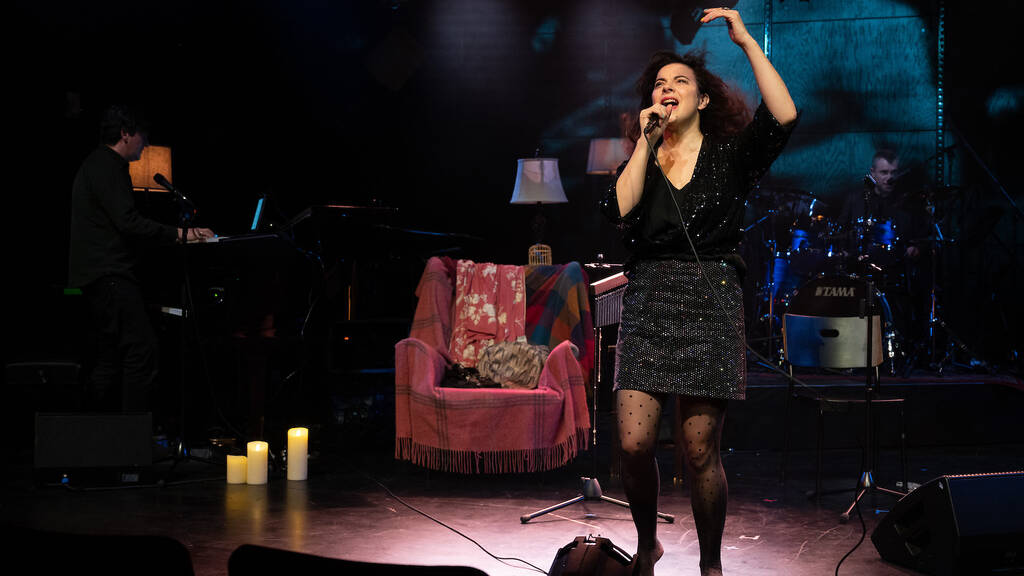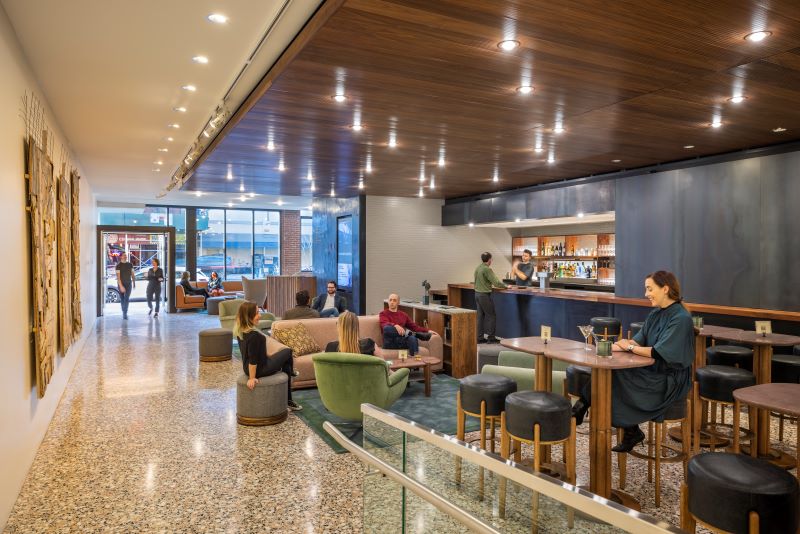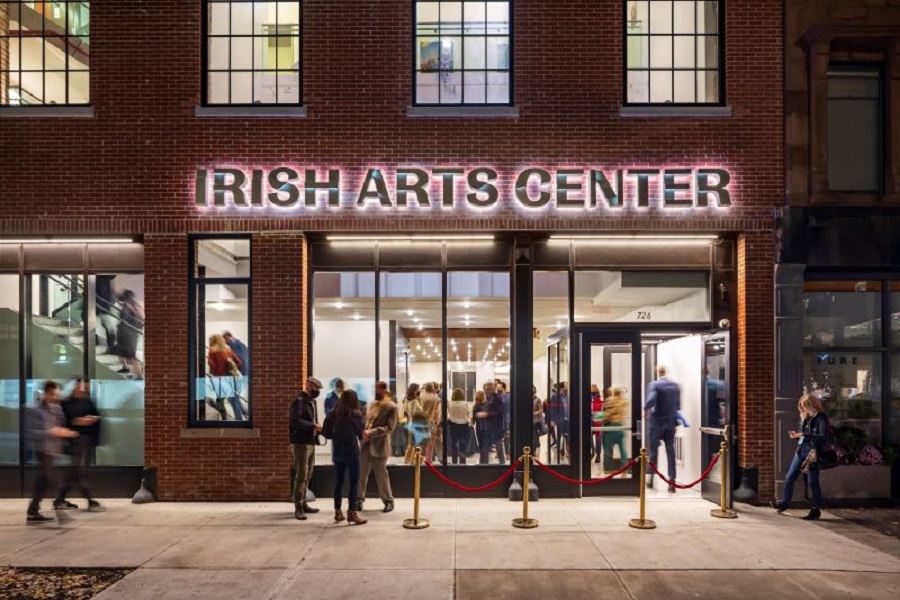I was recently disappointed to be reminded that the New York Police Department in fact has no choir, which means that the central image in the chorus of the Pogues classic “Fairytale of New York” (“the boys of the NYPD choir still singing ‘Galway Bay’”) is, well, something of a fairy tale in itself. But dreams still can come true: Last week, when the Irish rock chanteuse Camille O’Sullivan closed Where Are We Now?, the inaugural show in the Irish Arts Center’s gorgeous new complex in Manhattan’s Hell’s Kitchen (running through Dec. 31), with a spirited, dynamically wide-ranging rendition of this holiday standard (she pointedly did not sling the song’s most infamous slur), she apparently had an off-duty member of that imaginary choir in the audience. Not quite a heckler, this somewhat over-eager fan at the back of the complex’s 170-seat theatre periodically called out song requests and commentary, and, when it came time for the finale, belted out the Pogues lyrics, even as O’Sullivan was trying to whisper them meaningfully out of tempo. “Does it feel like we’re in Ireland now?” she quipped to the audience.
The ties between New York City and Ireland may have been heavily mythologized over the years, but they are as deep and genuine as that of any immigrant population to the Big Apple. From St. Patrick’s Cathedral to Tammany Hall, from Fordham University to the Irish Rep, it would be hard to imagine Gotham minus Irish Americans. Among the main beachheads for Irish-American cultural exchange in the city for nearly 50 years has been the Irish Arts Center (IAC), which held classes, hosted world-class music events, and staged Off-Off-Broadway plays in a modest, cozy, low-ceilinged space in a tenement on 51nd Street since 1974.

Now IAC has made a noticeable upgrade, long in the works and delayed by the COVID shutdown, to a beautiful new four-story building, adjacent to its old space but facing 11th Avenue. The price tag for the 22,000-square-foot building, designed by Davis Brody Bond, with theatre consulting by Fisher Dachs Associates, is $60 million. A few months ago, executive director Aidan Connolly and programming and education director Rachel Gilkey gave me a tour of the nearly ready facility and recounted some of its long gestation.
It was as long ago as 2006 that conversation about a new Irish Arts Center began, with the city, interested in building more affordable housing on the block, pressing the company to move but offering to give it the adjacent space, then occupied by Cybert Tire & Car Care, for $1 “if we could figure out how to build the building,” said Connolly. The process of figuring that out, not to mention raising the money, took a good long while, which Connolly ultimately views as a benefit: It meant that “instead of simply giving ourselves a promotion,” the organization could “really take a step back and consider ourselves as temporary custodians of this moment, and think, what can we pull together for the future?” Among other things, that meant a pivot to the multidisciplinary—i.e., continuing to offer a full curriculum of classes on Irish dance, music, and language, but also presenting a wide mix of programming by Irish and Irish American authors, choreographers, and theatremakers.
So the company’s first season in the new space is slated to include the U.S. premiere of a pair of acclaimed Irish works: next month, Oona Doherty’s dance piece Hard to Be Soft—A Belfast Prayer, and the following month, Enda Walsh’s play The Same, as performed by the Irish company Corcadorca. Amid a series of musical, literary, and fine arts events will be two works commissioned under a program called Grásta: Grace in Uncertainty: an outdoor piece of some kind from Bill Irwin, and a musical reflection on biracial Irish identity by Sallay Matu Garnett (Loah). Connolly and Gilkey also spoke of their excitement that at last they’ll be able to bring the Dublin troupe Dead Centre to the U.S. to stage their metatheatrical Chekhov’s First Play.

“Our elevator pitch is always: an intimately scaled hybrid of the 92nd Street Y and BAM,” said Connolly, referring to the way 92Y has become a de facto capital of literary Jewish America, while the Brooklyn Academy of Music is known as a central destination for international performance. O’Sullivan’s form-breaking concert/cabaret makes a great first salvo, as well as a showcase for IAC’s state-of-the-art new theatre. Reminding me a bit of REDCAT, the arts center tucked in the corner of L.A.’s Disney Hall, the IAC theatre is a high-ceilinged box with comfortable risers on one end, a tension grid with 230 lighting instruments poised above, and a stage flanked by unistrut panels that can be positioned and repositioned at will.
At least as striking as the theatre space itself is where it sits within the four-story complex. Connolly said that after surveying more than 200 artists in all disciplines, both in Ireland and New York, about what they would want from a new Irish Arts Center, “The theme that kept coming back was hospitality, and this idea of a place for conversation, a place for ideas, a place for people to engage with each other.” So amid all the soul-searching and wrangling about programming and about “the artistic capability needed for the theatre,” Connolly said the message that came through was that “we’ve got a privileged social space. That led to the fundamental decision to make the ground floor a really generous social space, and to put the theatre in the air. Which architecturally was a big decision.”
The result: Patrons who enter from 52nd Street will be drawn through the lobby space toward a bustling bar and café (food and drink provided by the local wine bar Ardesia, something of a neighborhood treasure). When they’re ready to go up to the show, they can check in with a box office run from a modular podium, then take an elegant staircase (or elevator) up two flights to the theatre proper.
This inviting multi-use space, Connolly noted, shows promise as more than a mere social lubricant: It will also be an event locus for fundraising, what he calls “a big table” to gather stakeholders as well as donors. In addition to the mix of private and public money that went into the construction project, the company’s annual nut will likely hit $7 million in the coming year, so that raising money will continue to be a pressing mandate.
“It’s both a blessing and a burden when you express a sense of ambition—that you’re going to build a $60 million new Irish Arts Center in New York City,” Connolly said. “There’s a sense of expectation: If you are an Irish artist or arts patron, this place damn well better serve you.” In facing those high expectations, part of the company’s thinking has been that “we could use the calendar as a variable in our multidisciplinary-ness—meaning we don’t have to do everything at the same time.” Gesturing to classrooms on the building’s first floor by way of illustration, “We would love to have six classrooms, and to be honest, we probably would have demand for six classrooms. But we have room for two really great ones.”

Likewise, he said, in every choice about the new building, they’ve tried to think of “a primary function, a secondary function, and in some cases, a tertiary function.” The idea is to build in pliability not only for the next few years of programming but for the long term. “We want it to be the kind of building that the people who come after us can come in, and we haven’t over-engineered them into a corner where they’re not going to have choices to execute a different kind of vision. That notion of flexibility and kind of trying to future-proof it, while also having some humility about that, has been the challenge. The ambition of the project has kind of required us to sort of really do it in layers over time.”
Time is a recurring theme here as well. While Hell’s Kitchen was still at least vestigially an Irish American neighborhood when the IAC was founded in the early ’70s, most of that community has long since decamped to Woodlawn in the Bronx, or to Woodside and Sunnyside in Queens, if they’re still in New York City at all. Connolly said he sees the mission of the IAC as serving “the next 100 years, a time when Irishness will not be what it was in the 20th century, just as any immigrant culture evolves. At a meta level, we feel our role in the landscape is to create a cultural platform that can help shape that identity.”
It’s a bold, forward-looking vision, embodied in a space that marks a welcome addition to the New York cultural landscape at a time of grave uncertainty. And who knows? If a certain police force is looking for a place to form and rehearse a choir, they could do a lot worse.
Rob Weinert-Kendt (he/him) is the editor-in-chief of American Theatre. rwkendt@tcg.org


